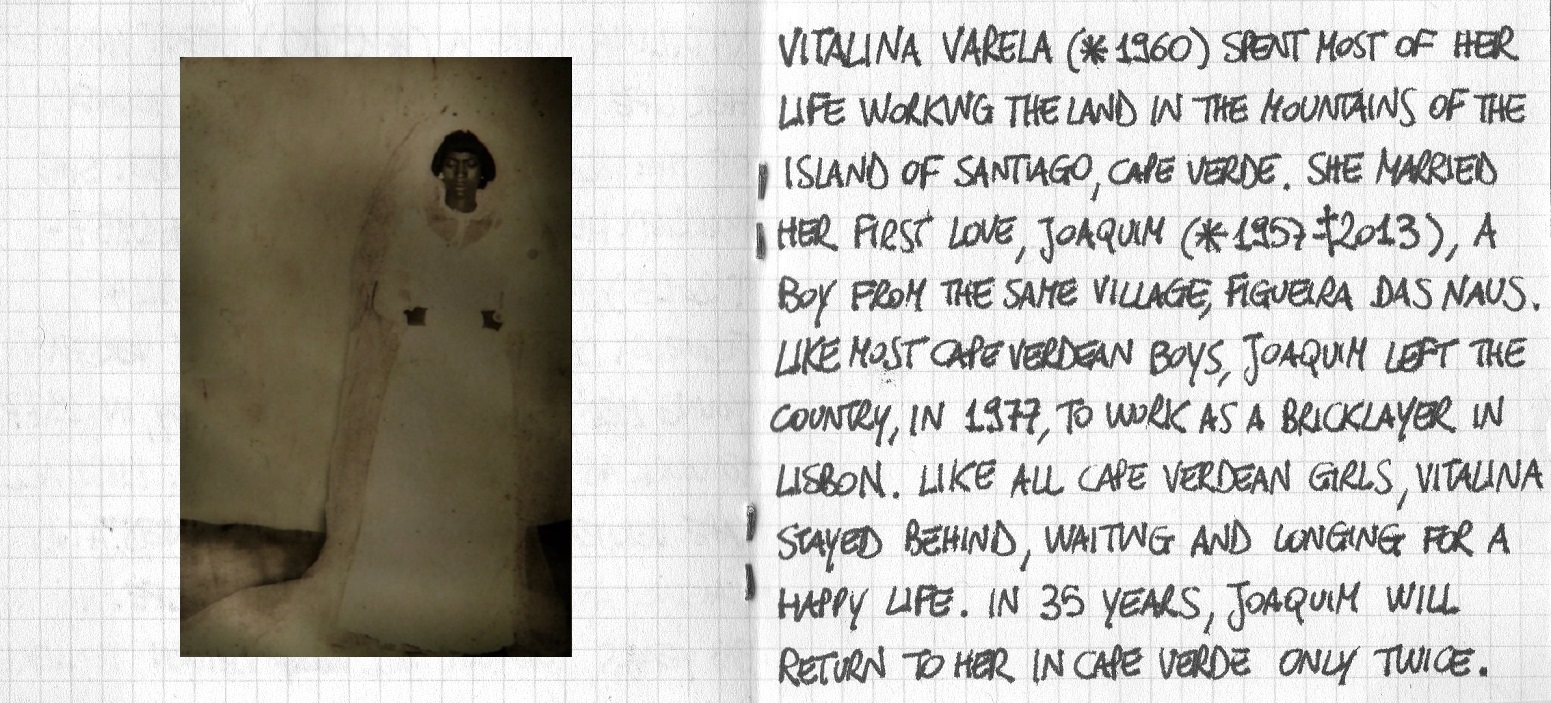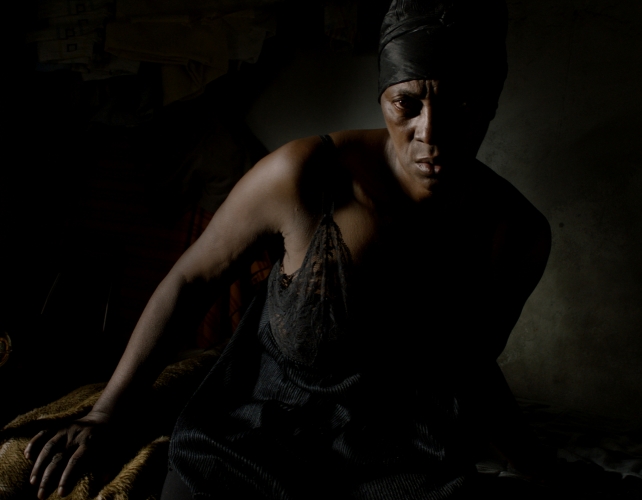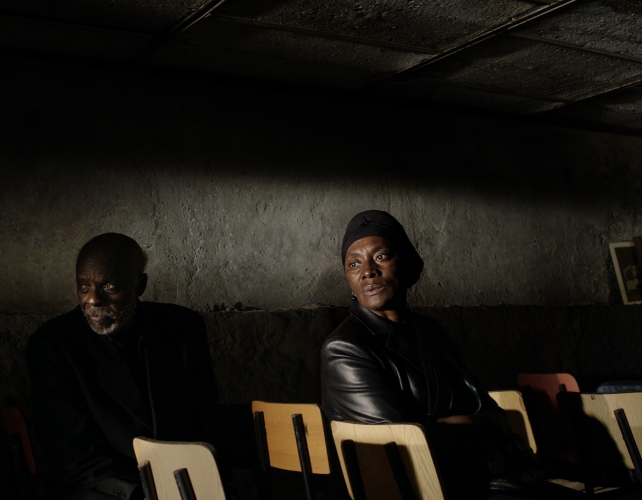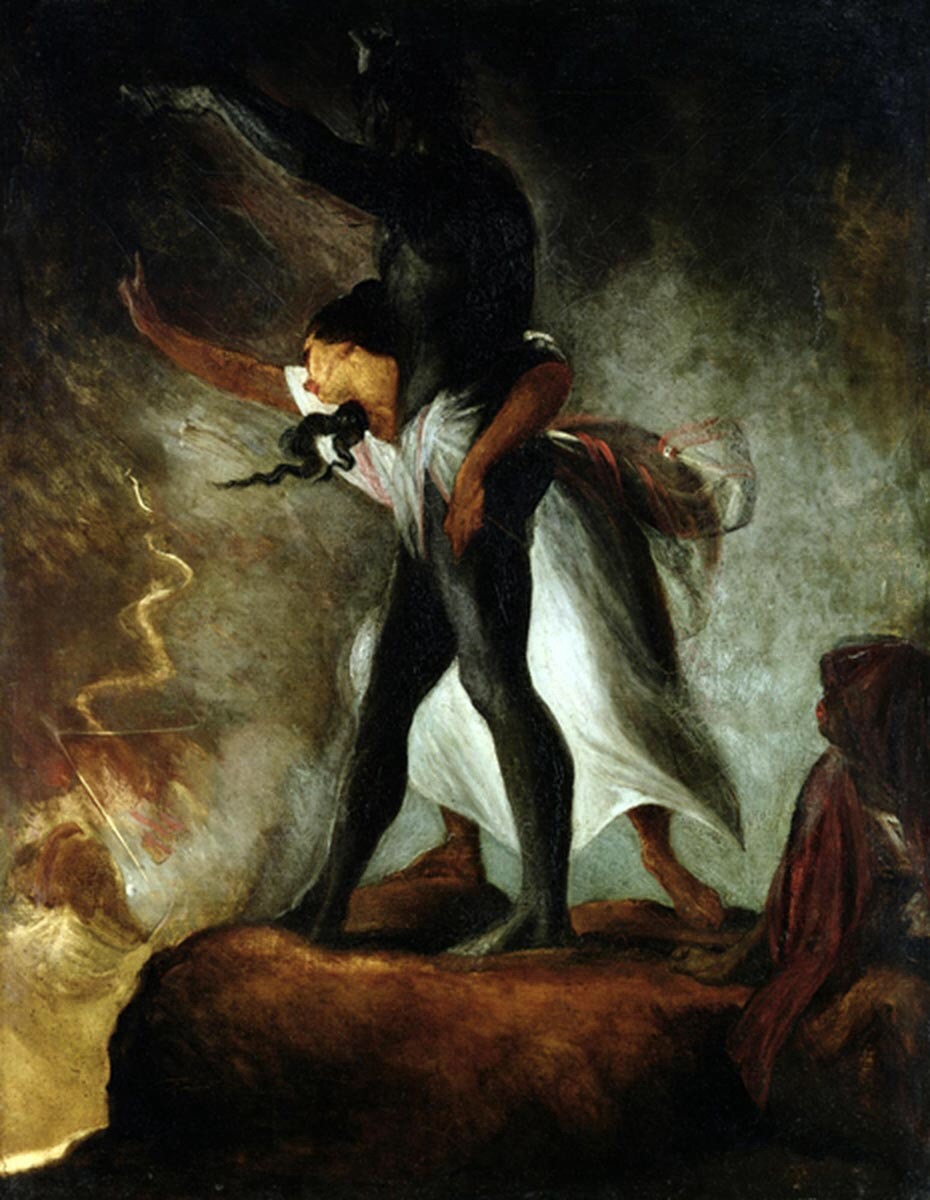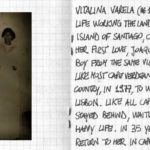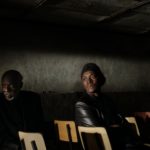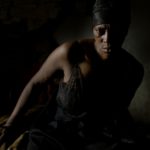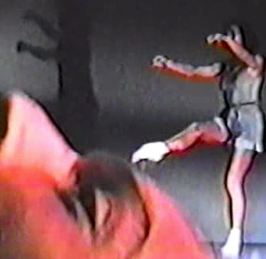Pedro Costa (2019)
Keeping the Flame Alive
Verás amor
verás que
o coração
não morre
que tanta comoção
atrás dele
corre
António Reis, Novos Poemas Quotidianos
After shooting Casa de Lava (1994) in Cape Verde, Pedro Costa returned to his hometown Lisbon and discovered the immigrant neighborhood of Fontaínhas, a bairro de lata [slum] populated mostly by Cape Verdeans who had left their arid, volcanic land in search of greener pastures that never materialized. In this now-demolished shantytown and in other peripheral ghettos of the Cidade Branca [White City] Costa found some good friends, and a disturbed, disoriented community whose long parade to the graveyard he has chronicled in the films Ossos (1997), In Vanda’s Room (2000), Colossal Youth (2006), Tarrafal (2007), The Rabbit Hunters (2007), Our Man (2010), Sweet Exorcist (2012), Horse Money (2014) and Vitalina Varela (2019).
In Costa’s own words, his latest feature Vitalina Varela is a companion piece to Horse Money, the two films completing one another by providing a masculine (Horse Money) and a feminine (Vitalina Varela) point of view on the daily struggles of Cape Verdean immigrants in Lisbon. In Horse Money, retired Cape Verdean bricklayer Ventura plays a slightly fictionalized version of himself trying to exorcise his bad memories, ghosts and demons in order to escape the shock corridors of a Bedlamesque hospital-fortress. At Ventura’s side in this odyssey of the mind is his recently widowed, distant cousin Vitalina Varela, cast in the small role of a magical helper of the voodoo kind. In Vitalina Varela, on the other hand, Vitalina is the star and Ventura the supporting character. Vitalina plays herself, a fifty-something Cape Verdean peasant who, due to visa issues, arrives in Lisbon too late to attend the funeral of her estranged immigrant husband Joaquim, while Ventura plays a half-mad, half-saint priest seeking to alleviate Vitalina’s grief and fury over the end of her love. “We share the mourning…”, says priest Ventura to Vitalina in a central scene of Vitalina Varela, “You lost your husband, I lost my faith in this darkness…”. Is the road that leads to acceptance and closure irremediably lost in the starless night ? Is the hope for a new beginning a mere utopia ? On a rainy weekend in Hamburg I sat down with Costa to have a talk and find out.
Pedro Costa : After making Colossal Youth I had the feeling that I was spending most of my time with Ventura, in a man’s world, so I was happy when Vitalina appeared in my life halfway through the shooting of Horse Money, in the autumn of 2013. The encounter with Vitalina deserved a film, it was that simple for me. I also felt that this encounter could give me the chance to approach another side of the story of the Cape Verdean diaspora – the women’s side of the story. Vitalina and I became friends and she agreed to play a supporting role alongside leading man Ventura in Horse Money, and the more I got to know Vitalina the more I knew that my next film would be with her and about her. I thought that she could be the star of a film about her own life, a film centered on her own memories and experiences, a sort of companion piece to Horse Money, with Vitalina as the main character and, perhaps, with Ventura in a supporting role. Actually, I started putting together this dreamed project with Vitalina while Horse Money was still in the shooting phase. I even got some funding for the Vitalina project, which I used to complete Horse Money. So, you see, Horse Money and Vitalina Varela are connected in many ways. They really are twin films.
Débordements : In the beginning was Vitalina…
P.C. : In the beginning was the Word, and the Word was with Vitalina, and the Word was Vitalina. [Smile] At the beginning of Vitalina Varela there was just Vitalina and her dramatic arrival in Lisbon, to her late husband’s house in the neighborhood of Cova da Moura. The film slowly began to take shape and evolve as I started visiting Vitalina and talking with her every day : she was telling me all about herself, her runaway husband Joaquim, her two children, her peasant life in Cape Verde, her immigrant life in Lisbon… I listened to her memories and suggested some directions we could take in the film. Vitalina accepted some ideas and naturally rejected others. And I kept doing my job : suggesting, adding, concentrating, getting it tighter and tighter. This way, we began to build an itinerary for this woman. Sometimes, between ourselves, we joked a bit because it almost felt like an absolute Via Crucis [Way of the Cross, Way of Sorrows]… And then, in the summer of 2015, Horse Money won the ARRI/OSRAM award at Munich Film Festival and I got to choose an Arriflex camera and two Arri lenses. I immediately summoned my friend, the DP Leonardo Simões, and we had a discussion about this new equipment in relation to the place where I wanted to shoot most of the film, Vitalina’s house, which is very small and quite dark. We chose two wide angle lenses, a 15mm and a 28mm, we tested them thoroughly and we got some nice results, so it began to seem possible to set the film in Vitalina’s house.
D. : You also rented a film studio for the shooting of Vitalina Varela…
P.C. : No, not an actual film studio, we would have never had the budget to do such a folly ! It was an abandoned film theatre in Sacavém, which we converted into our own studio. This way, we had two base camps for the shooting : Vitalina’s house in Cova da Moura (our main set) and the abandoned cinema in the neighboring area of Sacavém.
D. : A film-theatre-turned-film-studio ?
P.C. : Exactly. The experience of Horse Money taught me that I had better find a big space where we could build some sets and record direct sound. As we couldn’t afford to rent a film studio, we started thinking of a plan B, meaning an industrial or agricultural warehouse in the outskirts of Lisbon, preferably around the Amadora area, where Cova da Moura is. Time passed and we couldn’t find anything usable, so I had the idea of scouting the suburbs for abandoned cinemas. You know, back in my childhood days, Lisbon used to have quite a few 400-or-500-seat cinemas. Most of them closed in the 1980s and over the years they were either sold to strange Catholic-spiritist cults or left in a state of complete abandon. One day I was passing through Sacavém, a neighborhood close to Amadora with a big African community, and I noticed this film theatre called Cinema São José [Saint Joseph Cinema]. The cinema seemed to be abandoned, so I contacted the owner and I explained him what I wanted to do. He told me that Cinema São José was active in the late 1960s and throughout the 1970s, then it closed at some point in the 1980s; it became a disco in the 1990s, then it closed again; it became a sleazy Brazilian church, then it closed for good. The owner guided me on a visit and it was amazing : the main theatre was 30 meters long by 15 meters wide, and 12 meters high; the seats were still there, the balcony was still there. Everything was decrepit, almost in ruin, very dirty. However, I saw a possibility for our small crew to get some good work done in there, so my production partner Abel Chaves and I came forward with a proposition. The owner agreed on a reasonably fair monthly rent, and we took the place for two years. That was more or less what our budget allowed. Once we got the place, we did a lot of scrubbing and cleaning, some repairing, a bit of isolation work, and we took out the seats to make the main theatre completely empty. At that time I was only planning to reconstruct some parts of Vitalina’s house in our cinema, because I wasn’t sure that I could fit us all plus the camera and the lights in certain rooms of Vitalina’s house. Later, when we settled on the idea of having Ventura play a priest, we decided to build the interior of his church in our cinema. Some corners and back alleys of Cova da Moura were also reconstructed there.
D. : The shot with the tunnel and the city lights faraway in the distance is really great. Where is that place ?
P.C. : It’s a passage underneath a freeway. It’s the freeway between Ventura’s neighborhood and Nhurro’s neighborhood. Do you remember Nhurro ? He’s the black boy in In Vanda’s Room and one of Ventura’s “sons” in Colossal Youth. Ventura lives in Casal da Boba, the neighborhood with the white cubicles featured in Colossal Youth, while Nhurro lives in Casal da Mira, another social housing complex. The tubes that you see shining on the walls of the tunnel are water pipes. The Cape Verdeans use these tubes to bring water to the vegetable gardens that they have all over the outskirts of Lisbon. Like all Cape Verdean immigrants, Vitalina has a couple of tiny vegetable gardens close to her house in Cova da Moura – more or less clandestine, more or less tolerated. She was a peasant all her life in Cape Verde and she likes to farm the land, it makes her happy. She says that all her problems vanish when she works the land. So it was important to have the water pipes and the vegetable gardens in Vitalina Varela.
D. : The interior of priest Ventura’s church has been reconstructed in your studio, but what about the exterior? Is it a real church?
P.C. : Yes, it’s a real church built by the African community in Quinta da Lage, just 500 meters from Cova da Moura. The church is just a plain shack. It doesn’t have the name of a patron saint, it doesn’t have a priest, it doesn’t have a congregation. It’s used only for a daily 4 pm rosary, with four or five old people in attendance.
D. : I remember this story that you told about your friend and colleague Jean-Marie Straub. Once upon a time, Straub reprimanded some young students by saying: “If you start laughing when you hear the word ‘God’, you are never going to make a film !”. What does the word “God” evoke to you?
P.C. : Nothing much, to be honest. But Vitalina is a believer, like most Cape Verdeans of her generation. God couldn’t be avoided in Vitalina Varela. It’s a bit like the drugs in In Vanda’s Room : I couldn’t possibly make a film with Vanda without filming the drugs. I mean, perhaps I could have, but it wouldn’t have been a film about her. Anyway, as for Vitalina, her faith kept coming up during our conversations. Talking about her journey – this painful Via Crucis from Cape Verde to Portugal – she was always stressing that her only companion was God. She had no solidarity, no help from anybody. Actually, she told me this terrible story : the first weeks after her arrival in Lisbon she spent locked in her husband’s house, alone, until one day she went to the church of Damaia, near Cova da Moura. She went there to get some food and comfort and to talk a bit with some kind soul, but she got a very hostile reception. The church’s social workers gave her neither material nor spiritual help. They simply told her : “What are you doing in Lisbon? Shouldn’t you go back to your country ? Your husband is dead and buried, your life isn’t here. Here in Lisbon we are going through very difficult times… economic crisis…”. So Vitalina left and vowed never to go back to that church. She found herself another church to go to Mass (she goes to Mass every Sunday), and she prays alone, in her house. God is a part of her life. More than that, God is a part of her solitude, so there was no way I could avoid this presence in Vitalina Varela. Maybe we had a little help from above to make the film, who knows? [Smile]
D. : Vitalina has only one crucifix in her house. In the film, she keeps it wrapped in her white foulard [head scarf], on a little altar dedicated to her dead husband.
P.C. : That’s part of the mourning ceremony in the African community : a little altar with the crucifix, the candles, the photos of the deceased and the plate to collect a bit of money to help the family of the deceased. We go to a funeral, the dead person is buried and that’s more or less it. We don’t generally keep altars in our homes for weeks. In the African community, on the other hand, mourning still has a certain ritual, a certain… sacralidade [sacredness]. Since you mentioned the foulard… At the beginning of the film, Vitalina arrives in her dead husband’s house and she changes her foulard from black to white. That’s part of the Cape Verdean funerary rites. The widow usually wears a white foulard for the funeral wake, the Mass and the burial. Then, when the public ceremonies are over, the domestic, private mourning begins and the widow wears a black foulard. In real life, Vitalina couldn’t attend any “official” ceremony because she arrived too late, everything had already been taken care of. But since in real life she didn’t have the chance to take part in the public ceremonies, she insisted on doing the ritual wearing of the foulard in the film. I guess that Vitalina somehow wanted to claim her spousal right to perform this funerary ritual. So, in the end, Vitalina’s desire to properly commemorate her dead husband met something that I think cinema must continue to do : keeping the flame alive. All our crew understood this – Vitalina, myself, Leonardo at the camera, Gazua at the boom, the assistants Vítor and Leão, and João the production manager : the mourning was the shooting, and vice versa. Actually, for better or worse, when shooting, I often find myself living much more with the dead than with the living. Cinema is a very powerful ring-ring to the Other Side. By the way, Vitalina Varela will have its theatrical release in Portugal on 1 November [on the eve of the Day of the Dead]…
D. : In your films, crosses are never a good sign. For instance, in Casa de Lava a cross is painted on the door of the houses of the infected, while in Ossos and in In Vanda’s Room a cross on the façade marks the immigrants’ houses to be demolished. So when, at the very beginning of Vitalina Varela, I saw the cross-shaped gravestones along the street and the purple cross painted on a wooden pole, I was overcome by a sense of foreboding. Maybe it’s only me, but I was instantly reminded of the words written on the gates of Hell in Dante’s Inferno : “This road leads to the city of pain, to the eternal torment, to the lost people”.
P.C. : Mark your words in red paint. [Laughter] For me, a cross is first and foremost a way of marking the unknown… During my first visits to the immigrant neighborhood of Fontaínhas, in the mid-1990s, a Cape Verdean whispered something that stuck with me forever. He said : “In Fontaínhas you have to be careful where you put your feet. The plane tickets for the living are much cheaper than the plane tickets for the dead…”. After that, I noticed that the people of Fontaínhas never stepped on certain cobblestones, they never walked on certain spots in certain alleys… and I noticed the marks carved on poles: not only crosses, names, dates of birth and death, war cries, menaces, but also palms of hands, blood stains, human traces.
D. : I quoted Dante because, when I see Ventura lost in the dark woods of both Horse Money and Vitalina Varela, I think of Dante lost in the dark forest at the beginning of Inferno, and I think of this holy desire to make something epic, something divine out of the troubles, doubts and sorrows of lost human beings…
P.C. : Thank you, I take it as a compliment. But even if Vitalina and Ventura inspire me the highest feelings and emotions, I’m just going for a little bit of… dignity. You know, at first I simply listen to the stories of Ventura, of Vitalina, of all my friends from the Cape Verdean community. They share their life stories with me and for these gifts I feel extremely grateful. Then, when the time for action comes, I need to struggle to preserve those highest feelings and emotions : it’s not rare that – in the midst of the dispersion that a shooting always entails – one loses the first reason to make a film, and here the risk is to betray the dignity and violate the secrets, the intimacy of my Cape Verdean friends. In filmmaking, it takes a lot of work to keep the intimacy intimate !
D. : At the end of Horse Money Ventura leaves the hospital-fortress : his illness can never be cured, but he seems revitalized, more energetic, ready to roam the streets once again. However, in the first two shots of Vitalina Varela, he appears to be in such a bad shape… Ventura – the founding father of Fontaínhas, the quiet leader of the long parade of the displaced Cape Verdeans – almost can’t walk anymore !
P.C. : Vitalina Varela was a bit more difficult to shoot than Horse Money. For all of us, and especially for Ventura. During the shooting of Vitalina Varela, sadly and unfortunately, Ventura had two heart attacks, one quite mild and one a bit more serious. The first stroke happened one afternoon while we were preparing to shoot : I was worried when Ventura told me that he felt his left arm going numb, but it was just a gasp and it all passed in a minute. The second stroke consigned Ventura to a hospital bed, where he stayed for one month. Then he had to do therapy for quite some time. Ventura gave us all a scare. He himself got quite scared. During the shooting of Vitalina Varela we all had to take turns and be closer to him, to make sure that he was assisted all the time. Ventura’s scenes were mostly shot in the cinema we rented, where we had heaters and everything to make Ventura as comfortable as possible. I have told it a few times : Ventura, Vitalina, Vanda, they belong to a great lineage, they are studio actors. They need a certain protection, a certain enclosure, a certain light.
D. : How did you have the idea of casting Ventura in the role of a Catholic priest who lost his faith ?
P.C. : The idea came very late, a few months into the production. Father Ventura appeared because of some stories that Vitalina told me. She told me that, after her arrival in Lisbon, she resisted the impulse of visiting the grave of her husband Joaquim. She was so depressed and so furious with him that she didn’t want to see his grave. She postponed the visit to the cemetery for weeks and weeks. Then, one night, she left her house in Cova da Moura, she wandered around, she got lost and, after a while, she started following someone in the streets. Vitalina was convinced that this person would somehow lead her to the cemetery. But, instead, Vitalina found the makeshift church in Quinta da Lage. Then, Vitalina told me another story, a true story that happened in the parish of her village in Cape Verde. One Sunday, a young Cape Verdean priest refuses to baptize a group of people for some idiotic bureaucratic reason, these disappointed people leave in a van, the van crashes and everybody dies horribly. The guilt-ridden priest loses his mind and becomes a beggar howling in the streets of Cape Verde. Like a madman in Marguerite Duras’s novels. Therefore, the high ranks of the Catholic church “deport” the poor priest to Portugal, where – according to the rumors – he survives in extreme poverty, homeless. Ventura knew the story as well and his eyes twinkled with malice every time he heard it… That was it !
D. : The Ventura of Vitalina Varela, an unnamed priest who lost his faith in the darkness, seems to bring to the extreme consequences the fragility, loneliness and doubts of the unnamed priest of a film you love, Diary of a Country Priest (1951) by Robert Bresson…
P.C. : It’s impossible not to think of Bresson’s Diary of a Country Priest, it’s an unforgettable film. Like the young priest of Ambricourt, Father Ventura wants to pay the debts of his parishioners with his empty hands. Like the young priest of Ambricourt, Father Ventura is exhausted, drunken, downcast. But in Father Ventura there is also something of the strong preacher of Stars in My Crown (1950) by Jacques Tourneur. It’s that gleam, that childish twinkle in his eyes… Father Ventura has a sparkle of the humor and wit that belong to the miracle man played by Joel McCrea in Stars in My Crown.
D. : Do you think that priest Ventura will ever be able to say that “All is Grace”, like the unnamed priest does at the end of Diary of a Country Priest ?
P.C. : I hope so. [Pause] You know what? In a way, I think that Father Ventura does say it. While talking with Vitalina in the deserted church, he whispers : “Fear can also enter Heaven…”. There you have it !
D. : So, will there be any stars in Ventura’s crown when at evening the sun goes down?
P.C. :[Laughter] Of course there will. Of course.
D. : Priest Ventura has troubles performing the rhetorical tasks of his ministry because he lost his faith, but he does offer concrete help, like paying for the fines and bills of his parishioners, even if he himself has no money. To quote Diary of a Country Priest : “What a wonder that one can give what one doesn’t possess ! Oh, sweet miracle of our empty hands !”
P.C. : You know, our work is a slow-burning work. A small ray of sun hits the bare ground inside the church, Father Ventura has nothing else to give. He opens his shaking, empty hands. A sweet miracle. The films we make are a little bit like that. I can’t give much to my Cape Verdean friends. I can’t give them a lot of money, I can’t give them a bright future, I can’t give them hope. But maybe there is everything to gain from our work in cinema. Cinema can set the record straight and, somehow, those who have been wronged will be avenged. A sweet miracle, indeed.
D. : Among the offerings in priest Ventura’s church, there is a box of Knorr cubes. Is it a reference to the Knorr cubes scene in In Vanda’s Room, in which Portugal is called the poorest, saddest country of all?
P.C. : In Vitalina Varela there is this young man called Ntoni, who comes to Vitalina’s house selling jars of beans, tuna cans, broth cubes, shampoo and other stuff that he “finds” at the supermarket… Boys like Ntoni are very common in Cova da Moura, their “rounds” are part of the economy of the place and a big help to the local residents. These boys are very diligent and useful. We live in a Knorr cube world, a Zara world.
D. : The tramp Ntoni, and his mother looking for him all over the neighborhood to give him hot food, seem to stem from the autobiographical stories that your friend Nhurro tells in In Vanda’s Room and Colossal Youth.
P.C. : Yes, it’s an echo of the ancient prayers and cries that I heard a long time ago in Fontaínhas. Sometimes I remember echoes of distant whispers and they come back, discretely, in the background or in the soundtrack of the films I make… [Pause] Yes, Ntoni and his mother are an echo of what my friend Nhurro told me a long time ago in Fontaínhas: “When we young Cape Verdeans fall into this pit, we become outcasts for our families. We could be dying just outside our parents’ house, but we can’t go in, we will die outside…”. It was like that in the late 1990s, when I first met Nhurro. The voice of his mother calling for him stayed with me all these years. It still haunts me as much as it haunts him.
D. : How is Nhurro nowadays? I saw his name in the credits of Vitalina Varela, but I couldn’t recognize him in the film.
P.C. : Nhurro appears in one shot of the film. Just in one shot. Nobody has discovered him yet. [Smile] But he’s doing great, every day he cooks for fifty kids at the kindergarten. It’s his job. The kids love him!
D. : Let’s now focus on Vitalina.
P.C. : She’s the main actress, she’s the scriptwriter, she’s the instigator, she’s the source. What do you want to know?
D. : Tell me more about her loneliness.
P.C. : Even in her wedding photographs Vitalina is alone ! You know, in the early 1980s she and Joaquim married by proxy : Vitalina was in her village in Cape Verde wearing her white wedding dress, Joaquim was somewhere in Lisbon, where he had migrated in 1977 – some signatures were made, some letters were exchanged between churches, and the union was made legal. After the proxy marriage, Joaquim went back to Cape Verde a couple of times, he got Vitalina pregnant twice, he ran away from her and then one day in 2013 he died. Now what’s interesting to me is that, after many years of long-distance marriage, Vitalina had put her husband aside. She knew that he had another life in Lisbon, she couldn’t do anything about it. Vitalina and Joaquim had two children, a boy and a girl, so from time to time Vitalina had to deal with Joaquim, send him some documents regarding the kids and things like that. But Vitalina was done with Joaquim. And then, suddenly, Joaquim died and everything came back to her. It was a clash between the grief and the fury. There was, and there still is, quite a drama tearing Vitalina apart : she’s mourning the end of her love and, at the same time, she’s still fighting with Joaquim about his lies and escapades. She conceives of his death as his supreme act of cowardice. We can wonder : why did she take that plane to Portugal ? Why did she decide to stay in her dead husband’s house forever ? Her choice is a mystery. Why does she want to stay in Portugal ? Every time I talk with her, she’s always going back to Cape Verde, to her village, to the mountains, to her little plot of land, to her animals, to the wind of the island, to the sun… Why does she stay in Lisbon, then ? It’s a frightening question… On the one hand there is the call of the land, on the other there is a furious rage, an indictment against all Cape Verdean men, against all men.
D. : Vitalina is literally surrounded by men.
P.C. : A man’s world is a violent, sad world. The men that you see in the film are the friends, colleagues and neighbors of Joaquim : bricklayers, beggars, retired masons, part-time dealers… drunken, broken men of all ages. The only woman Vitalina meets is Marina, Ntoni’s girlfriend, and shortly afterwards Marina dies, burnt alive… When I first met Vitalina I felt the desperation, but I also felt the anger, the revolt : she’s tackling the question of man, she really wants to come to some sort of resolution with men and get them all out of her life. So, in Vitalina Varela, I needed to align all the men in front of Vitalina, like in a police lineup.
D. : However, it seems to me that, in spite of her rage, Vitalina brings a small ray of hope to the drunken, broken men of the neighborhood : she keeps priest Ventura company and shares his mourning, she cooks for Ntoni and perhaps convinces him to go to church…
P.C. : In order to answer the question – the riddle – of man, Vitalina is trying to understand the loss of these men. Maybe… maybe she could console them…
D. : Like the Virgin Mary, Vitalina is the Consoler of the Afflicted, she’s Our Lady of Consolation. And yet, as soon as this Black Madonna arrives in Lisbon, all her fellow immigrants urge her to go back to Cape Verde: “Here in Portugal there is nothing for you. Go back home !”.
P.C. : Those are the plain facts. Those were the first words Vitalina heard as she stepped out of the plane that took her to Lisbon: “Your husband is dead, you don’t have a life here, go back to Cape Verde, it’s better for you, we can’t have another one…”. In a way, I think that her suffering and grief were too scandalous, and the people of the neighborhood didn’t want to confront any more scandals. The first scenes of Vitalina Varela are in suspension because Vitalina might go back to Cape Verde… she could stay in Lisbon for a couple of days and then go back… but no, in the end she stays, and the film is with her. She wants to stay and the film lingers with her. She wants revenge, she wants to avenge herself, and the film is on her side. She tells her dead husband: “You coward, you can’t run away anymore ! You have to tell me all the things that you didn’t tell me back home !”. And she waits for a sign of relief…
D. : Even Joaquim’s house in Cova da Moura seems to physically reject Vitalina : she’s awakened by strange noises in the middle of the night, the roof caves in, a brick falls on her head…
P.C. : Well said : Joaquim’s house rejects Vitalina. I guess that I have a fondness for doors opening or closing on their own, beds shaking, books falling from the shelves…
D. : I would like to ask you about a subplot that runs somewhat mysteriously through the film… Do the people of the neighborhood think that Vitalina isn’t Joaquim’s wife ? Do they think that the actual wife is Joaquim’s lover, “the other Vitalina” ?
P.C. : It’s just another sociological cliché. In the 20th-century history of African migrations, it’s the man who goes to the new country first, leaving his girlfriend or wife behind : “I will work abroad for one or two years, I will save money, I will send you a plane ticket so you can join me…”. These are the promises. But, needless to say, after a few months in the new country, most immigrant men become… alienated (to use a very old word). The men fall under the spells of the urban, Western society – the pleasures of the bright, naked city – and they forget to send the letters and the money, they forget to call. And then, one day, the immigrant man meets another woman, an African woman also living the immigrant life in Portugal… So he gets married and finds himself with two families : one in the new country and one waiting back home. It’s a common story. According to the rumors Vitalina heard when she arrived in Cova da Moura, there was a “wife” and the family of that “wife” at Joaquim’s funeral. Hence the confusion among the people of Cova da Moura, when Vitalina occupies Joaquim’s house : “Is this the woman who was at the funeral ?”. But Father Ventura is never confused, he has seen a lot…
D. : A thing I like in all your Lisbon-set films from Ossos to Vitalina Varela is that you avoid the stereotype of the poor as good, meek, gentle creatures who wouldn’t hurt a fly. The people in the immigrant community are capable of great gestures of love and solidarity, but they can also be very mean, spread gossip, get drunk, take drugs, deal drugs, steal, cheat, betray and kill.
P.C. : If you are a serious filmmaker, if you are committed to working in certain places with certain people, dealing with the history of these places and the histories of these people, and if you are a little bit devoted to your craft, then you have to bust your brain so that your work will build into something that transcends the clichés. You said “poor”, but to me it’s about desperate people, it’s about their struggle – a struggle inwards into their most profound selves, and a struggle outwards against the wall that has been built around them, against the silence that has fallen over them. I’m working in a very disturbed, very disoriented community: these people used to be peasants in Cape Verde, then they migrated to Lisbon to work; in Portugal they were mercilessly exploited, they needed the money… I don’t know in what stage of progress or defeat of capitalism we are in, right now… I know that I can only work with this confusion. It’s very risky and challenging, but I have no interest in safe scenarios.
D. : In all your Lisbon-set films from Ossos to Vitalina Varela the women of the immigrant neighborhoods are much stronger than the men. Women like Vanda and Vitalina are more resilient, better emotionally equipped to face the loneliness, the hardships and the tragedies of life, as opposed to men like Nhurro, Ventura and Joaquim. In your films the men always have a kind of weak, at times pathetic side, whereas the women are forces of nature.
P.C. : What can I say ? Most of the times I agree with Vanda, I agree with Vitalina… I agree with them against myself. These films stand by them. [Pause] Having to speak more in general, I guess that we live in times of profound treason and most men don’t have the courage to live their own life fully. They are defectors, Vitalina is a resistance fighter.
D. : Resistance fighter Vitalina is not afraid to teach a lesson to the weak men of the community. For instance, she unceremoniously rejects Joaquim’s drunk comrade, who is perhaps trying to move her to pity and take Joaquim’s place.
P.C. : He’s a sneaky character. This man used to live with Joaquim. He has the key to Vitalina’s house, so he thinks that he has the key to Vitalina’s heart. He speaks in tongues, he speaks with Joaquim’s voice, he knows the couple’s secrets, their love letters. In one scene he has a broken arm, in the next scene he’s just fine. He’s a sort of shape-shifter. Anyway, Vitalina is not impressed, she leaves him crying in the kitchen and goes to church.
D. : She goes to church, where she gets angry with priest Ventura because men always fail to understand women’s sufferings.
P.C. : Yes, but Father Ventura is the only man who can’t betray her. What a relief ! The way I see it, Father Ventura is neither a man nor a woman in the film, or maybe he’s both… He’s trying to balance, console and adjust. It’s in this scene that Vitalina says my favorite line in the film : “When you see a woman’s face in a coffin, you have no idea of the suffering she went through…”. Vitalina wrote it. I’m just lucky to have the best scriptwriters.
D. : Watching the ending of Vitalina Varela, in particular Vitalina’s silent dialogue with Joaquim’s grave and the flashback of conjugal happiness back in Cape Verde, I was reminded of your teacher and friend António Reis’s words about the importance of “learning to say goodbye”.
P.C. : It takes some courage to say hello. But it takes a lot of work to say goodbye. It’s not easy. Deep down, Vitalina Varela is about Vitalina saying goodbye to a lot of things. At the end of the film, it’s our turn to say goodbye to Vitalina : all films must bid farewell to their characters, it’s unavoidable. Having said this, let’s have a brief thought for António Reis and Mikio Naruse. [Pause] As for me, after all that Vitalina endured, after all the struggle and pain of her Via Crucis, I didn’t want the film to lock her inside her house in Cova da Moura. It would have felt like a condemnation. It would have been easy and condescending and stupid. So the question was : how can we say goodbye to Vitalina and do her justice ? Well, just like its twin film Horse Money, Vitalina Varela seemed to me like an effort to go back in time, not for nostalgic or melancholic reasons, but to confront a bunch of old dreams and nightmares. During Vitalina Varela, Vitalina goes back and back, so I thought that, at the very end of the film, she must go back to the very beginning, and the very beginning is, of course, the beginning of her love story with Joaquim, the first sparkle of love and happiness.
D. : Do you think that, in real life, Vitalina has now reached a certain closure about Joaquim?
P.C. : I don’t know. But she will reach closure, like all of us must do at some decisive point. And, at the same time, we can never really say goodbye, can we? We can leave people and things behind, for better or worse, but we will never say goodbye to them for good. They will be with us, alive, inside of us, forever. “I never can say goodbye, no, no, no” : do you know the song by the Jackson 5 ?
Stills: A re-imagining of the press kit material for Vitalina Varela / A frame from Vitalina Varela / A frame from Vitalina Varela / Johann Heinrich Füssli's Der gerächte Neger (1806-1807) at Hamburger Kunsthalle.
